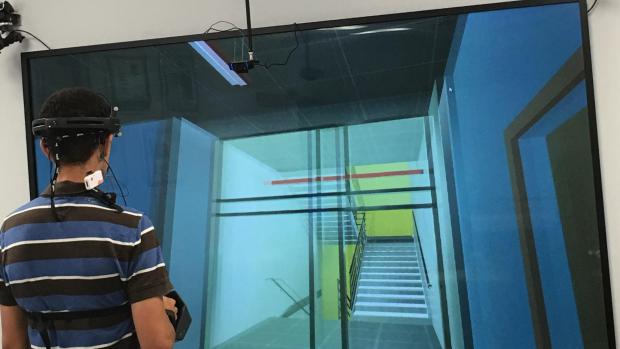Professor Ergan Lays Foundation for Buildings that Will Respond to Human Emotions

Someday buildings may sense how you feel and respond with subtle changes to lighting, color, and perhaps even structural features. To create this responsive architecture — built environments that can automatically change form, function, and behavior based on human needs — designers and architects will need data that quantifies the relationship between neuroscience and the built space.
Assistant Professor Semiha Ergan of the NYU Tandon School of Engineering’s Department of Civil and Urban Engineering is laying the groundwork with a unique program that explores not only how people feel about architectural spaces, but how their bodies and minds respond to them.
Beginning this summer, Ergan, a recipient of the prestigious DARPA (Defense Advanced Research Projects Agency) Young Faculty Award, will send people into virtual reality (VR) architectural spaces and use psychometric gear to measure their physiological, cognitive, and emotional responses.
“There are lots of studies in the architectural domain looking into how different design features might impact people,” she said. “Our aim is to holistically quantify that impact.”
Ergan and graduate students Ahmed Radwan and Luiz Arruda began the process last year by collaborating with top architects and designers to identify features that have a strong influence on peoples’ perception of a space. (Members of the group had an average of 20 years of professional experience.)
“We looked for a consensus on the importance of windows and natural daylighting, flexibility to isolate and socialize in spaces, scale, texture, color and material of surfaces, and direct and indirect exposure to nature,” she said.
Based on these insights, Ergan chose real building information models (BIM) — 3D representations of the physical and functional characteristics of a facility — for a crowdsourcing experiment with 300 people.
“The purpose was to eliminate architectural design features that people are indifferent about,” said Ergan. “We wanted to focus on those features evoking drastically different responses.”
Using respondents garnered from crowdsourcing site Amazon Mechanical Turk, Ergan created sets of paired images offering two views of the same section in a BIM. In one of the two images, however, a single architectural component — a window placement or size, the curvature of a wall, or the orientation of a staircase — differed. To understand how each participant felt about each image, Ergan employed what she calls a semantic bi-polar scale, a range of possible responses book-ended with antonyms like crowded and roomy, or pleasant and unpleasant.
Starting in late July, volunteer test subjects selected from a pool of NYU students, staff, and faculty will visit Ergan’s lab (the Future Building Informatics and Visualization Lab); don headgear, a hand controller, and body sensors; and move about a VR world of interiors derived from the most emotionally compelling BIMs. As the subjects explore and perform such tasks as finding a wall thermostat and changing its settings, Ergan and her students will measure their physiological status. They will also test subjects’ ability to recall positive, negative, and neutral words during the experiment as a way of gauging how they feel about the spaces.
“The assumption is that if they have a positive feeling about the space they will be inclined to remember positive words; if negative, they will remember negative words. Essentially, we will be evaluating whether what people said about these spaces correlates with what their bodies are telling us,” she explained. Beginning this fall, she and her students will parse the experimental data to help develop functional requirements of responsive spaces.
“The ultimate goal for us is to enable architects to design self-configuring forms that enrich human performance and adapt to the needs and bodily states of their occupants,” she said, adding that she envisions a future in which today’s static built environments make way for more customizable structures that maximize the productivity and comfort of occupants.
“What if a space could actually sense fear in its inhabitants and close itself off for safety, or if major architectural components could easily move to resize a room based on a specific need?” she asked.
The views, opinions, and/or findings expressed are those of the author(s) and should not be interpreted as representing the official views or policies of the Department of Defense or the U.S. Government.

